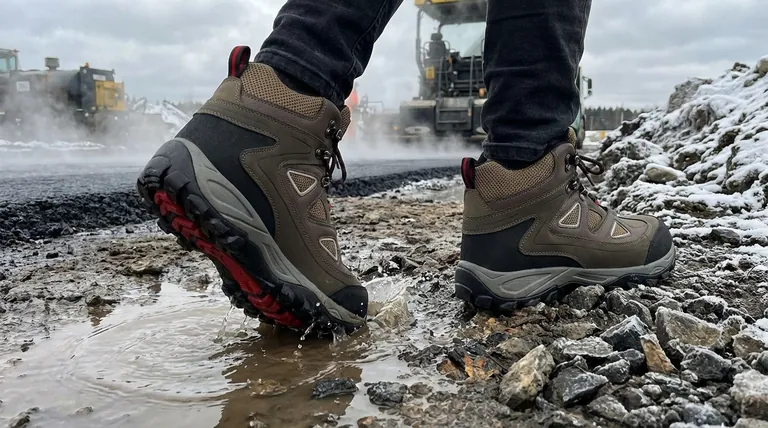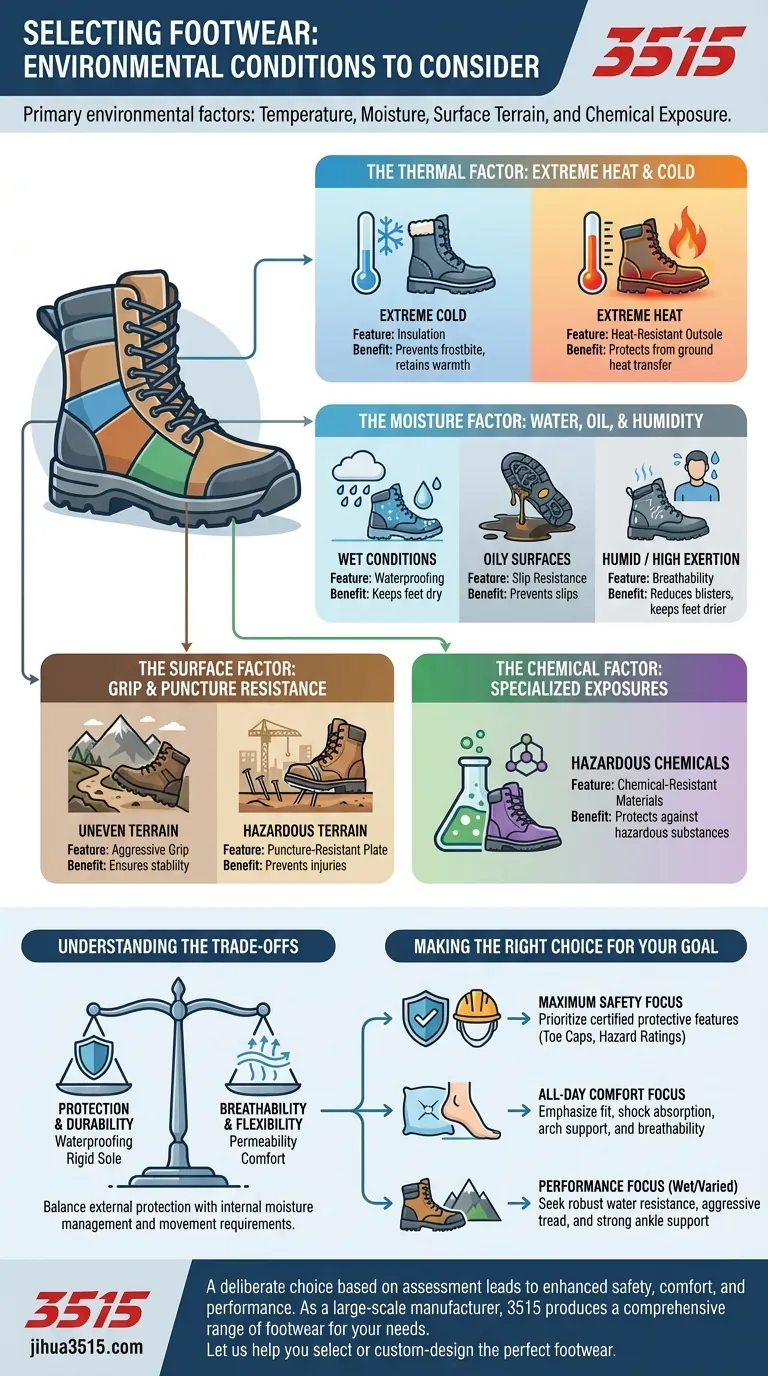When selecting footwear, the primary environmental conditions to consider are temperature, moisture, surface terrain, and potential chemical exposure. This assessment ensures your choice provides the necessary protection, durability, and comfort for your specific operational context, whether it's an industrial worksite or an outdoor trail.
Your footwear is not just an accessory; it is a critical piece of equipment that serves as the interface between you and your environment. A proper selection is a calculated balance between protection from specific hazards and the all-day comfort required for peak performance.

Analyzing Your Operational Environment
The most effective way to choose footwear is to conduct a clear assessment of the environment where it will be used. Each factor presents a unique challenge that specialized materials and designs are built to solve.
The Thermal Factor: Extreme Heat and Cold
Temperature extremes directly impact both safety and comfort. Footwear must be designed to manage thermal energy effectively.
For cold environments, insulation is the key feature. It traps air to slow heat loss, keeping your feet warm and preventing cold-related injuries like frostbite.
For hot environments, such as asphalt paving or foundry work, heat-resistant outsoles are non-negotiable. These materials are engineered to prevent heat from transferring from the ground to your feet.
The Moisture Factor: Water, Oil, and Humidity
Managing moisture is critical for preventing slips, discomfort, and foot health issues. This includes moisture from the outside environment and perspiration from within.
Water resistance or waterproofing is essential for any work in wet or rainy conditions. It provides a barrier to keep your feet dry and comfortable.
In oily or slick industrial settings, the outsole material and tread pattern must be designed for slip resistance on these specific surfaces.
For humid conditions or high-exertion activities, breathability is crucial. Breathable materials allow sweat vapor to escape, keeping your feet drier and reducing the risk of blisters.
The Surface Factor: Grip and Puncture Resistance
The ground itself presents significant hazards. The footwear's outsole is the primary defense against these threats.
An outsole with an appropriate grip and tread pattern is vital for stability on uneven, loose, or slippery terrain.
For construction sites or industrial areas where sharp objects like nails are a risk, puncture-resistant plates built into the midsole offer critical protection.
The Chemical Factor: Specialized Exposures
In certain industrial, agricultural, or laboratory settings, exposure to chemicals is a primary concern.
Footwear for these environments must be made from chemical-resistant materials. The specific type of material depends on the chemicals you will be exposed to, requiring a careful review of safety standards.
Understanding the Trade-offs
No single piece of footwear is perfect for every condition. Understanding the inherent trade-offs is key to making an intelligent choice.
Protection vs. Breathability
Heavy-duty waterproofing and chemical resistance often come at the cost of breathability. An impermeable boot that keeps water out will also trap sweat in. For high-exertion tasks, you must balance the need for external protection with the need to manage internal moisture.
Durability vs. Flexibility
The most durable, puncture-proof outsoles are often more rigid. While this provides maximum protection, it can reduce comfort and flexibility during activities that require lots of walking or climbing.
Specialized Features vs. General Use
A boot designed for a specific hazard, like welding, offers exceptional protection in that context but is often heavy and ill-suited for general wear. Choosing a specialized boot means accepting limitations in its versatility.
Making the Right Choice for Your Goal
Your final decision should be guided by a clear understanding of your primary objective.
- If your primary focus is maximum safety in a hazardous workplace: Prioritize certified features like protective toe caps, slip and puncture resistance, and specific hazard ratings (e.g., electrical, chemical).
- If your primary focus is all-day comfort for long hours on your feet: Emphasize proper fit, shock absorption, arch support, and breathability, while ensuring baseline safety needs are still met.
- If your primary focus is performance in wet or varied outdoor terrain: Seek a combination of robust water resistance, an aggressive tread pattern for superior grip, and strong ankle support.
Ultimately, a deliberate choice based on a clear-eyed assessment of your environment will lead directly to enhanced safety, comfort, and performance.
Summary Table:
| Environmental Factor | Key Footwear Feature | Benefit |
|---|---|---|
| Extreme Cold | Insulation | Prevents frostbite, retains warmth |
| Extreme Heat | Heat-Resistant Outsole | Protects from ground heat transfer |
| Wet Conditions | Waterproofing / Slip Resistance | Keeps feet dry, prevents slips |
| Uneven Terrain | Aggressive Grip & Puncture-Resistant Plate | Ensures stability, prevents injuries |
| Chemical Exposure | Chemical-Resistant Materials | Protects against hazardous substances |
As a large-scale manufacturer, 3515 produces a comprehensive range of footwear for distributors, brand owners, and bulk clients. Our production capabilities encompass all types of shoes and boots tailored to your specific environmental needs.
Let us help you select or custom-design the perfect footwear for your operational environment—contact our experts today to discuss your requirements and get a quote!
Visual Guide

Related Products
- Safety Footwear Wholesale Manufacturer for Custom OEM/ODM Production
- Wholesale Slip-On Safety Boots Manufacturer - Custom Puncture-Proof & Steel Toe
- Puncture-Resistant Velcro Safety Boots for Wholesale & Custom Manufacturing
- Premium Grain Leather Safety Boots for Bulk Supply
- Wholesale Mesh Steel Toe Safety Shoes with Dial Closure Factory Production
People Also Ask
- Is safety-toe as good as steel toe? Choose the Right Protection for Your Job
- What are the cultural perspectives on wearing shoes in the house? A Guide to Home Etiquette & Hygiene
- Is it normal to wear shoes in the house? A Guide to Hygiene, Comfort & Culture
- Do snake bite boots work? Your Ultimate Guide to Effective Snake Bite Protection
- What are the differences between steel toe, composite toe, and alloy toe Wellington boots? Choose the Right Safety Toe for Your Job



















